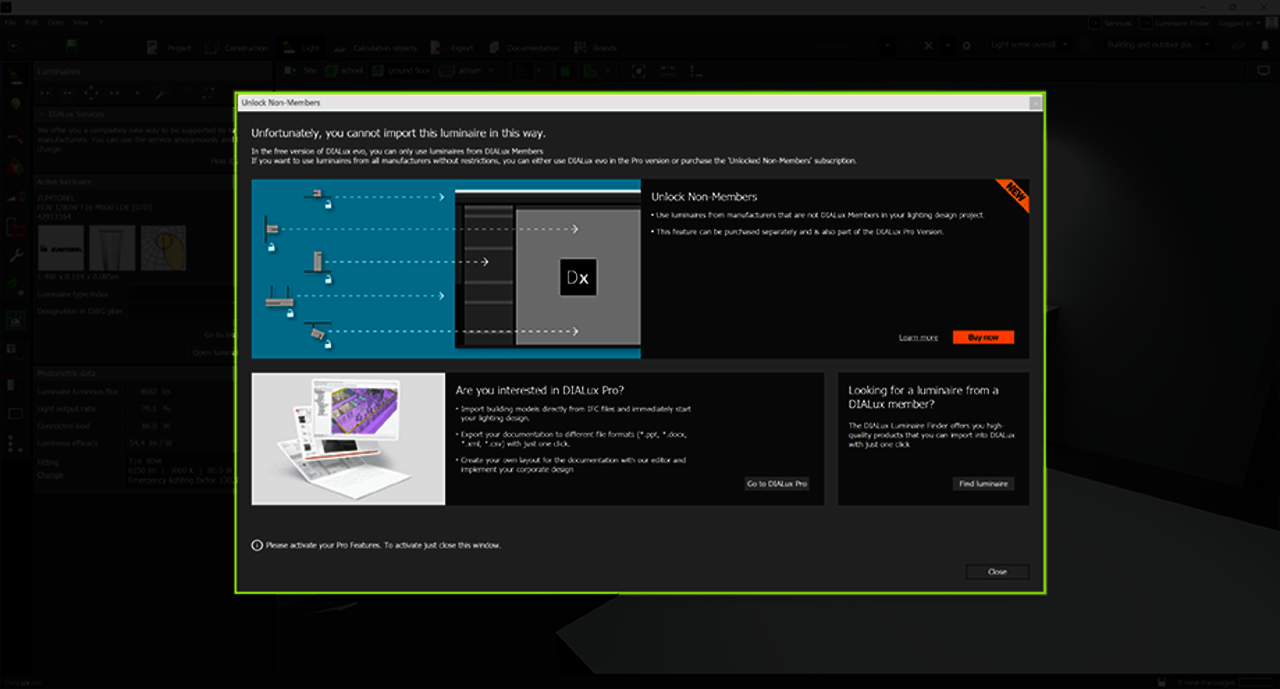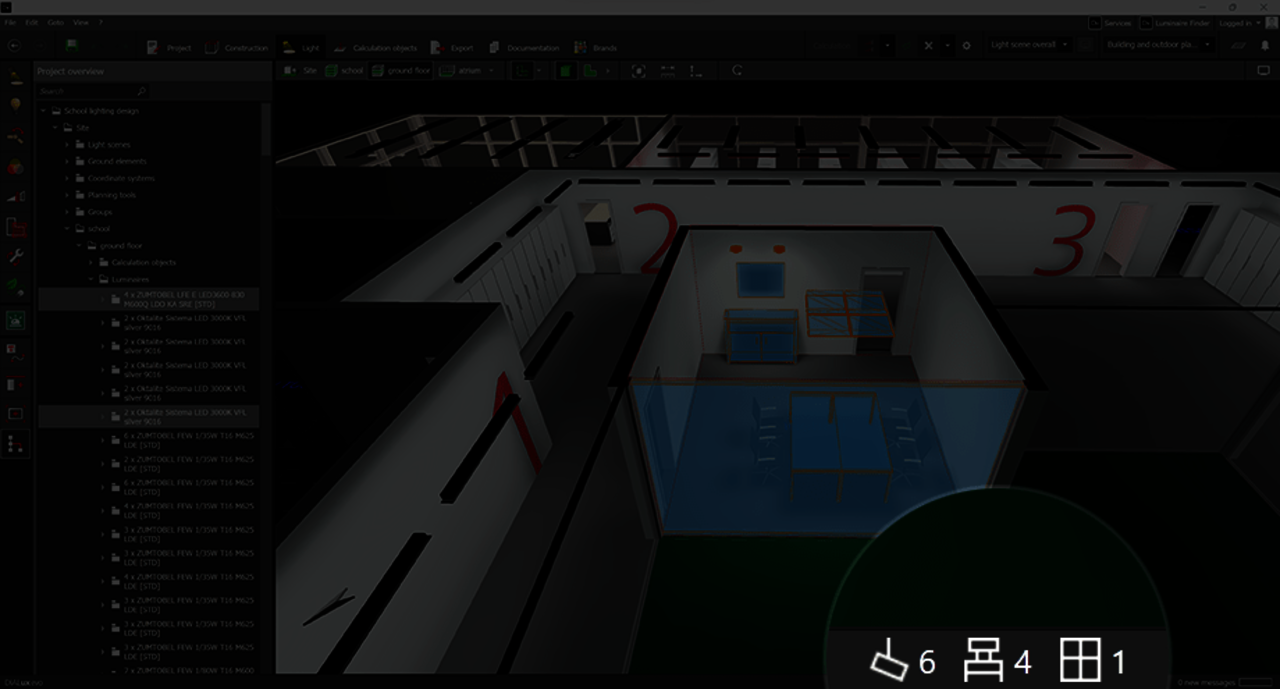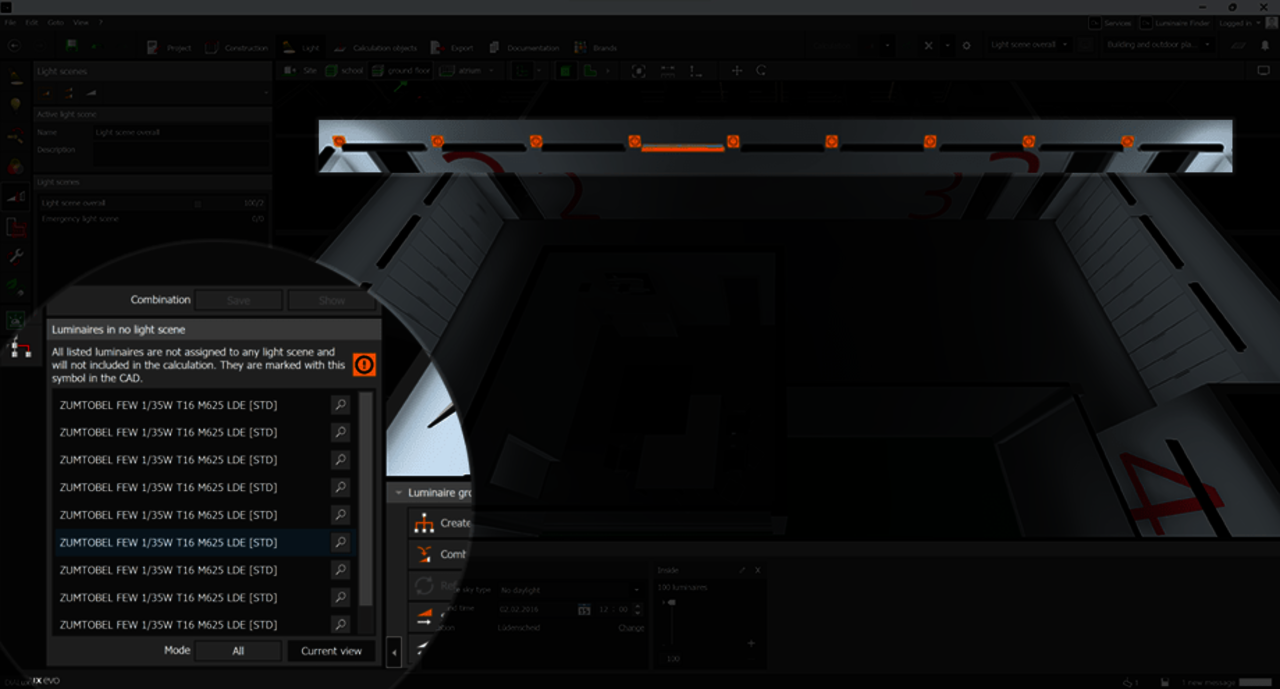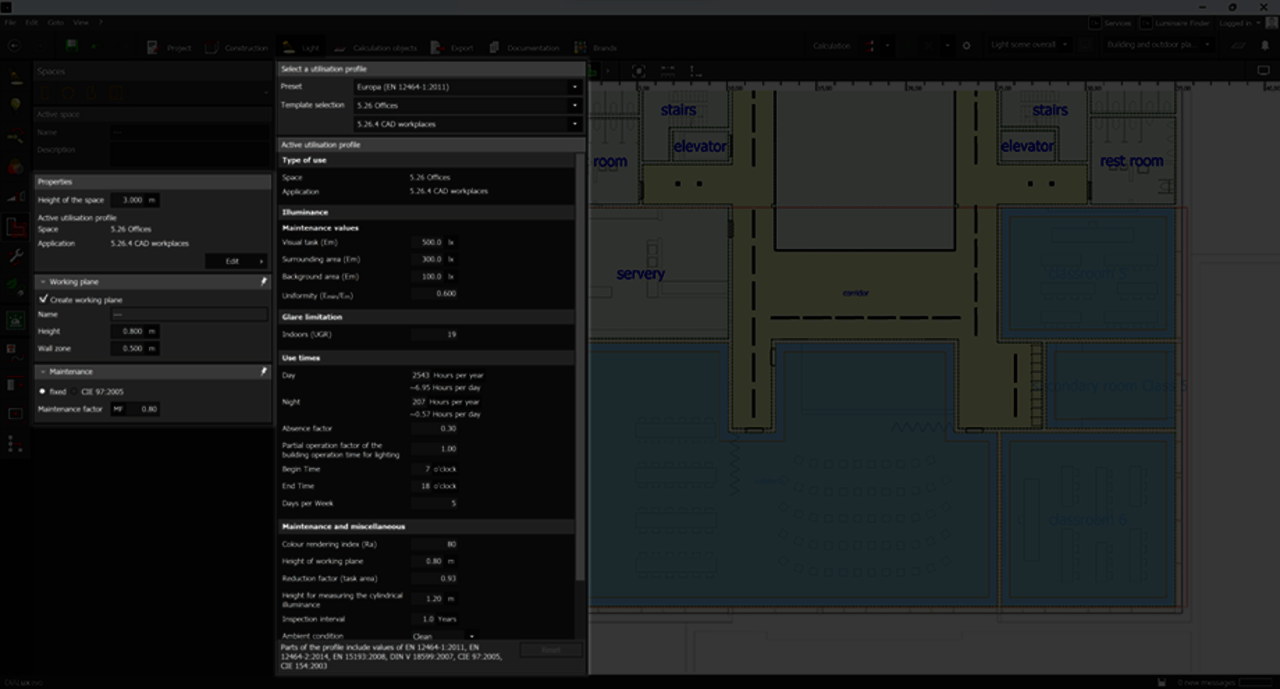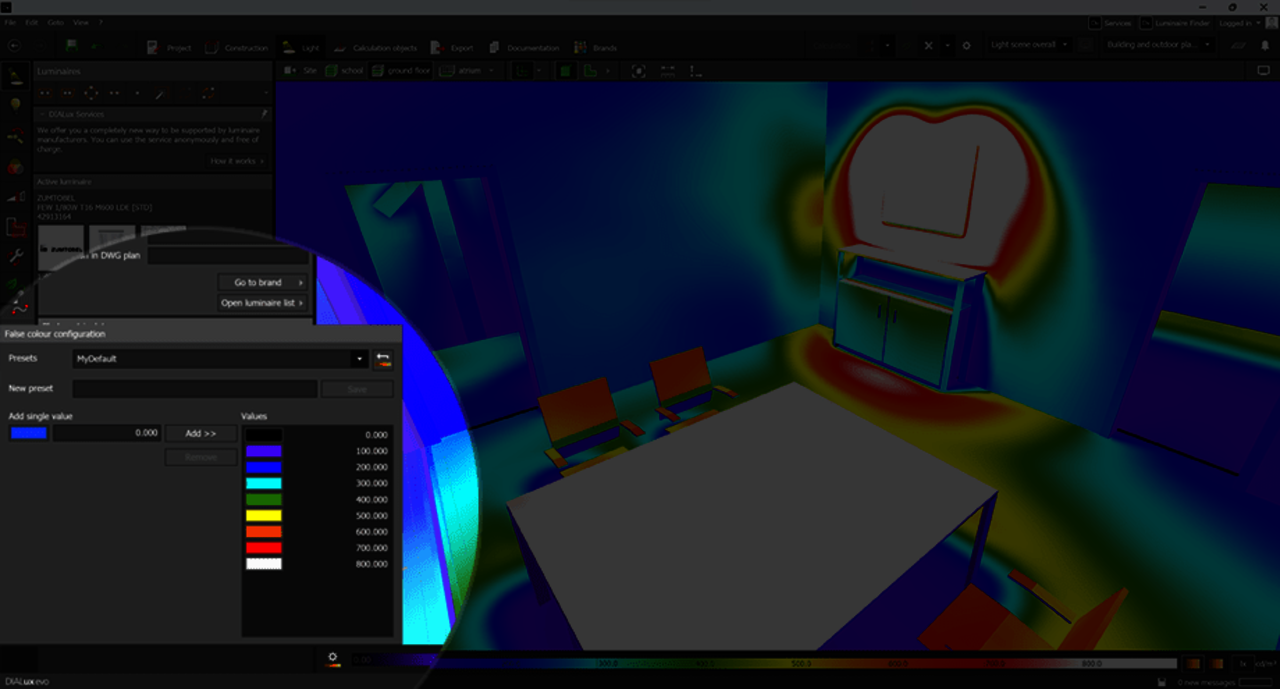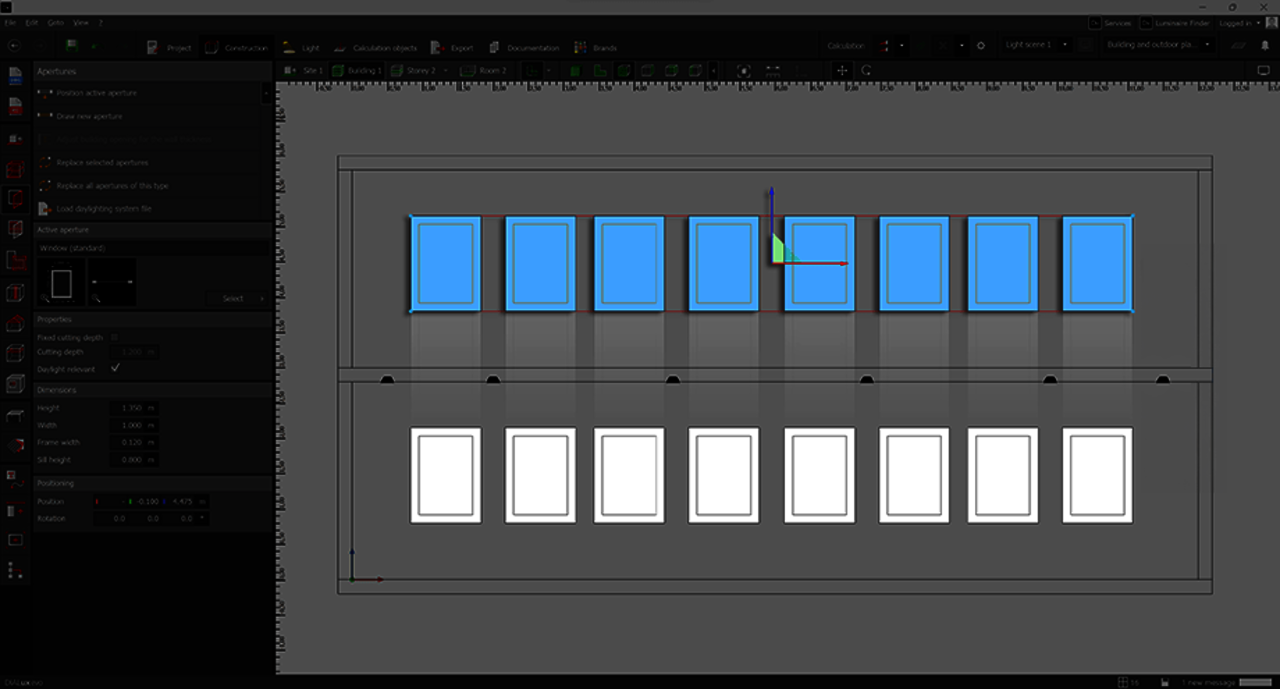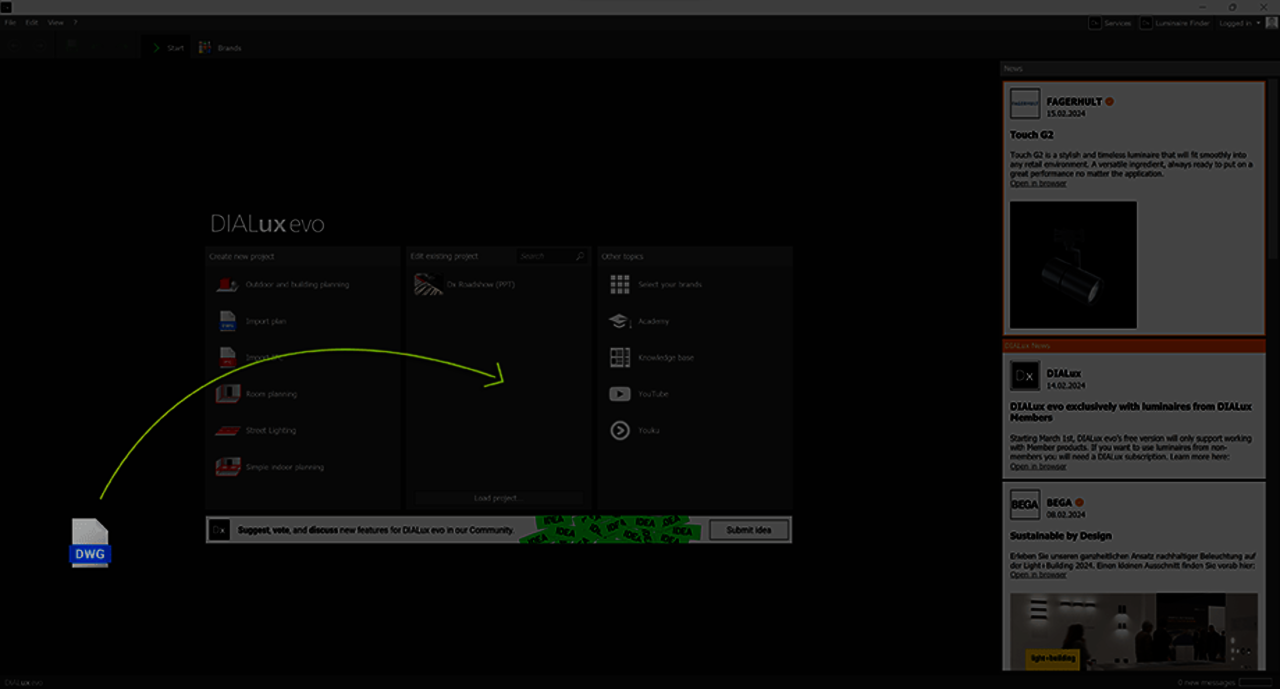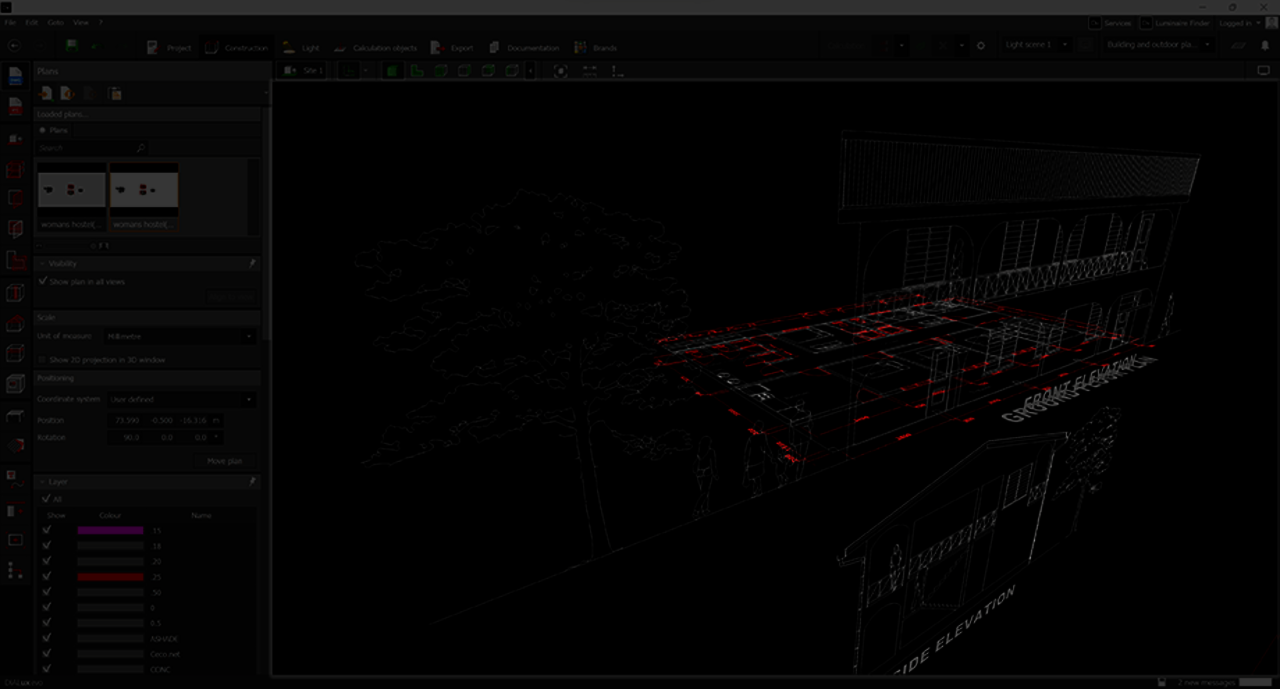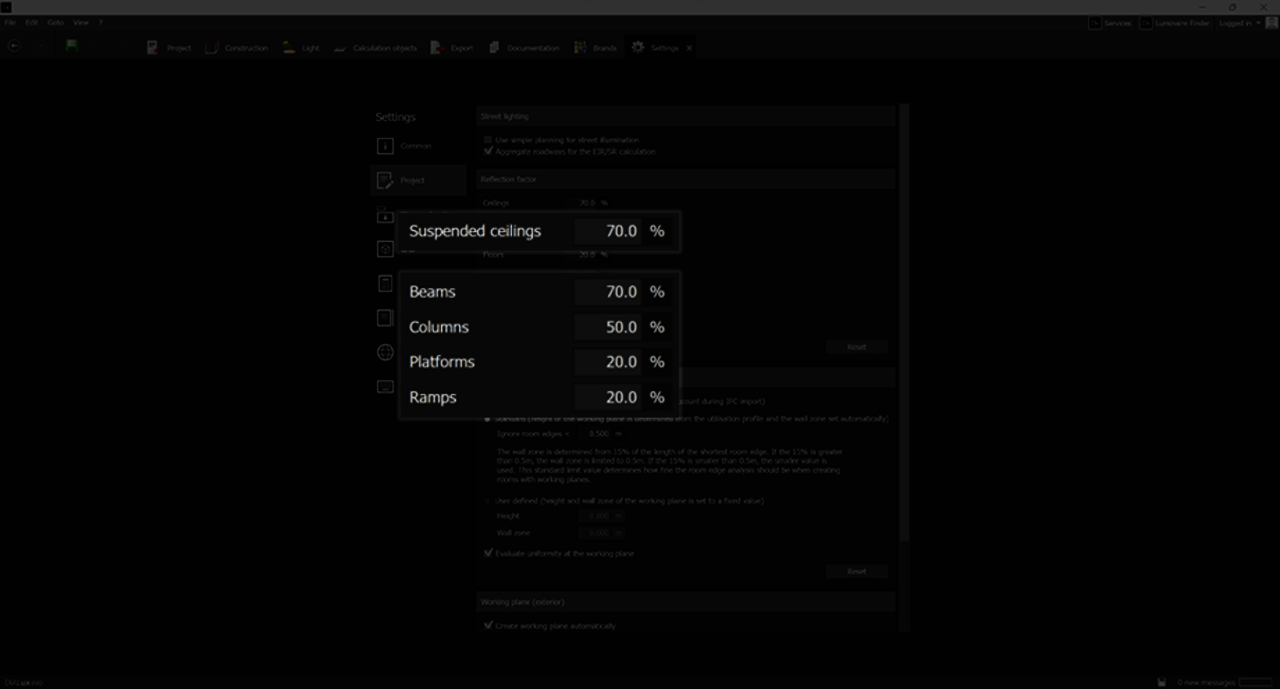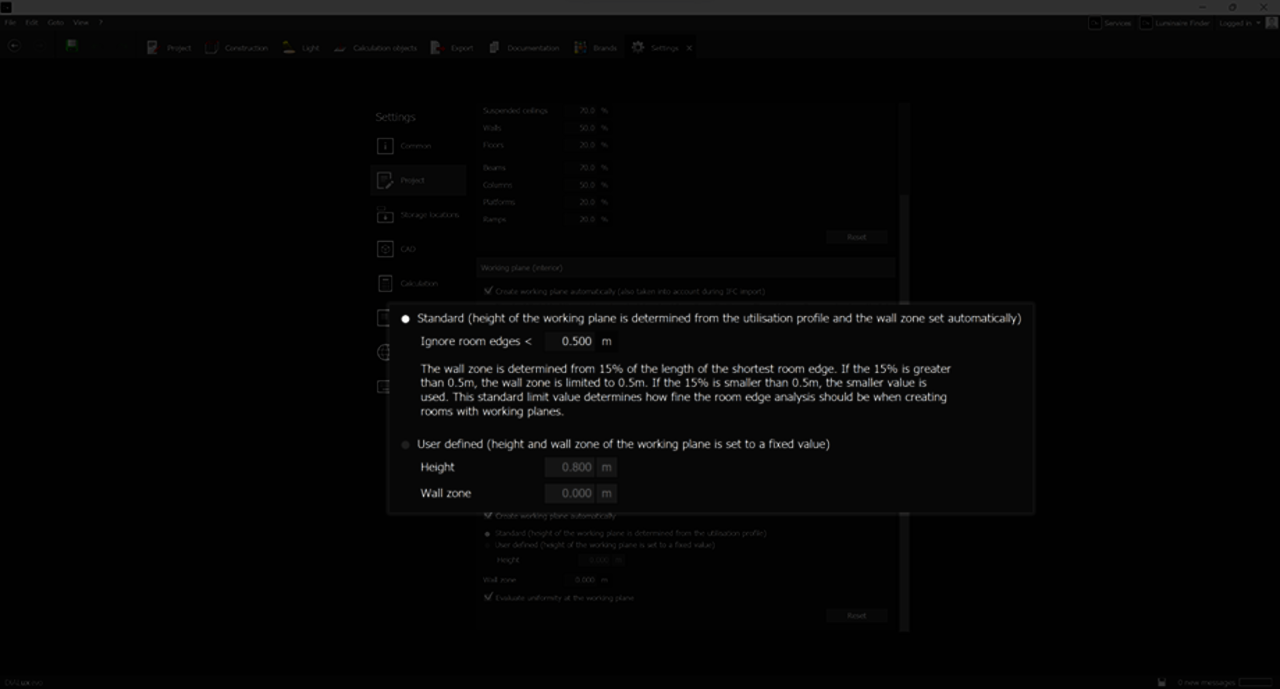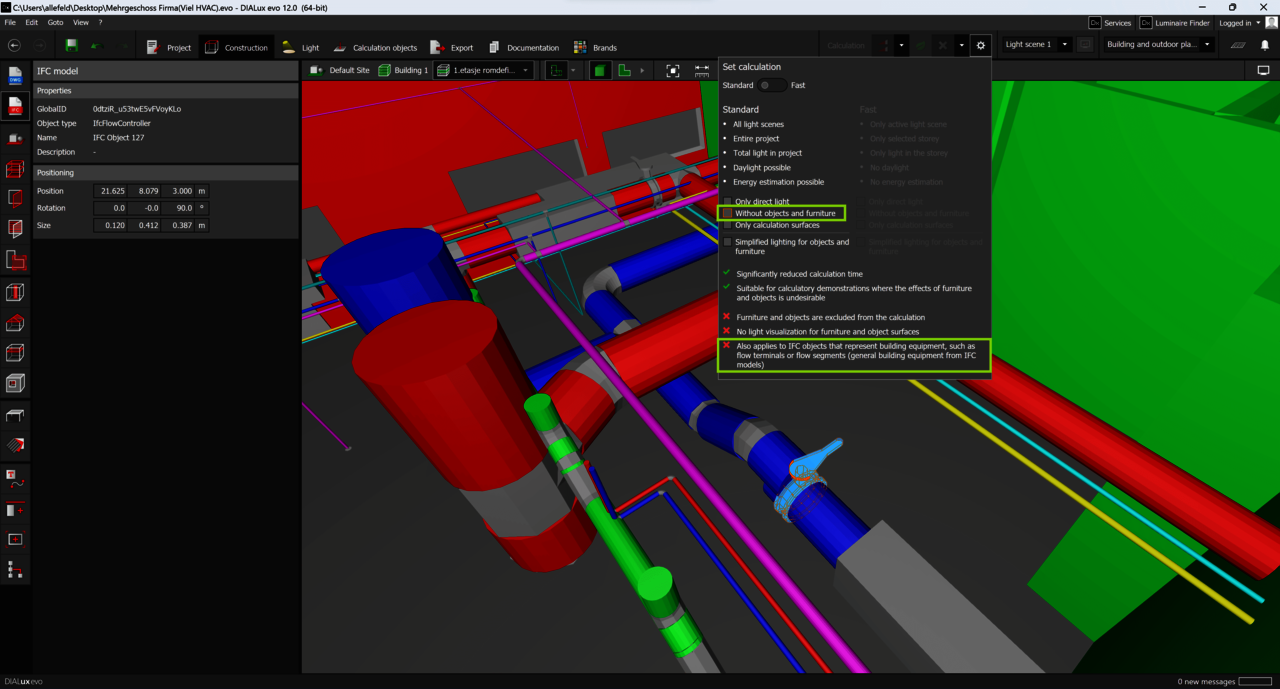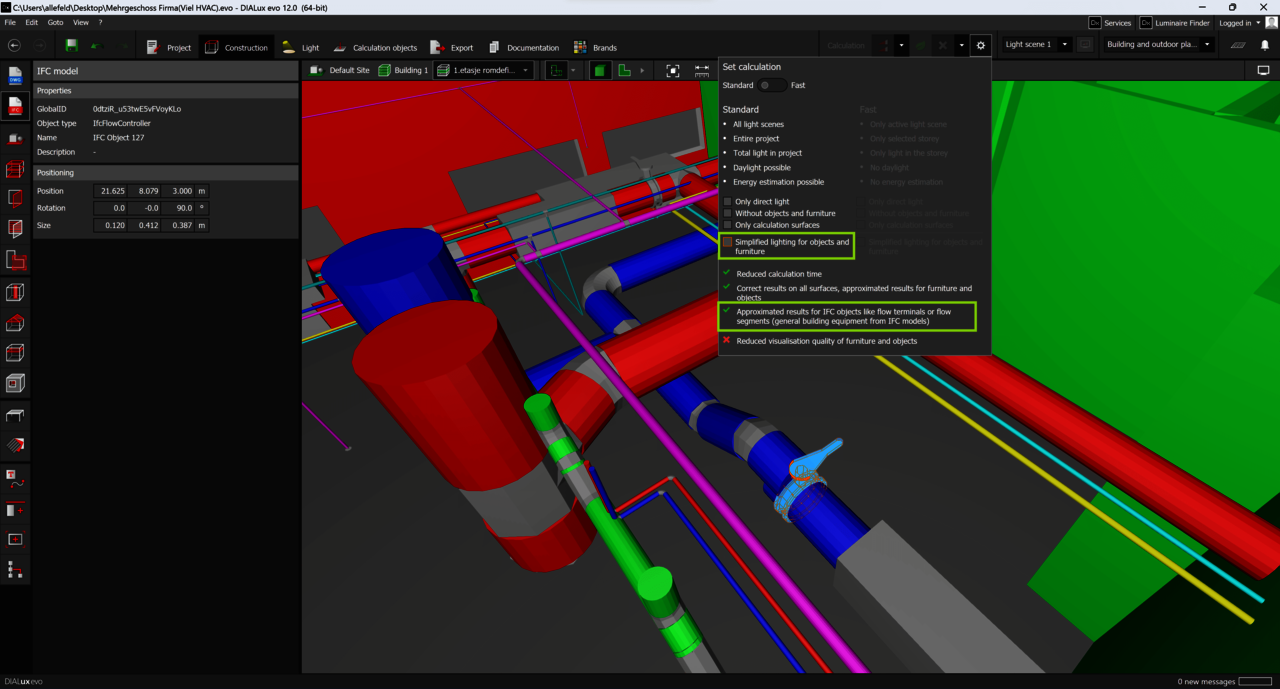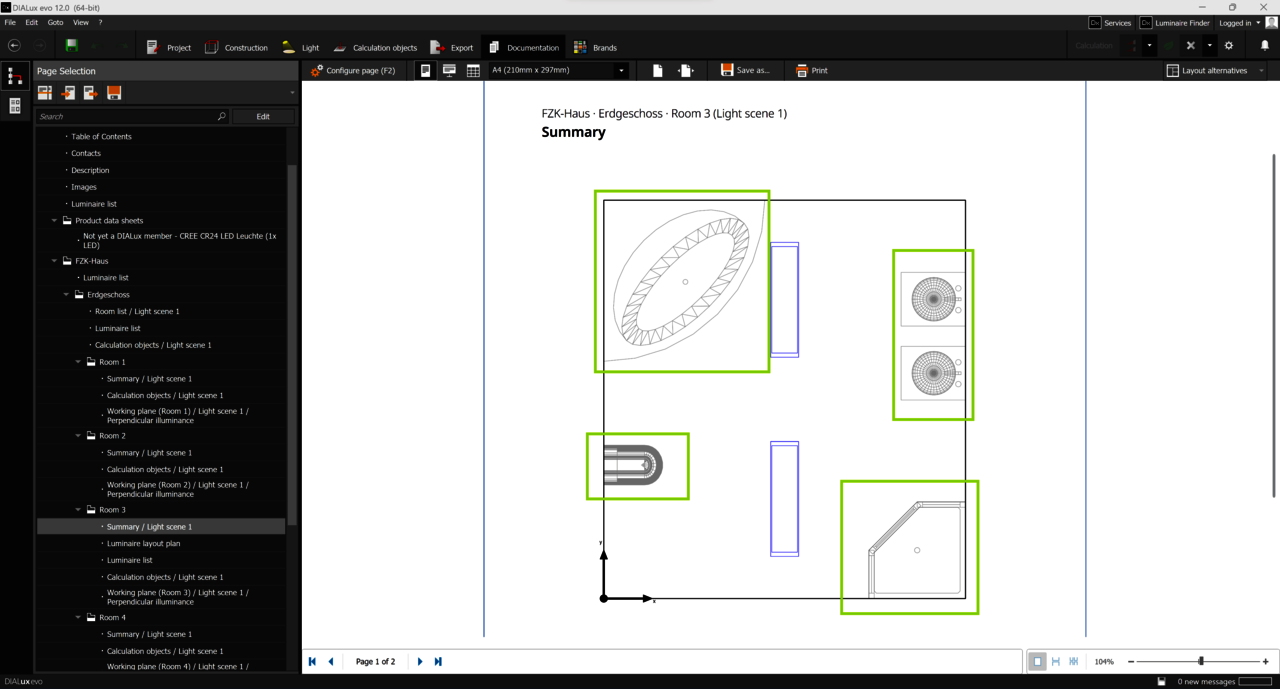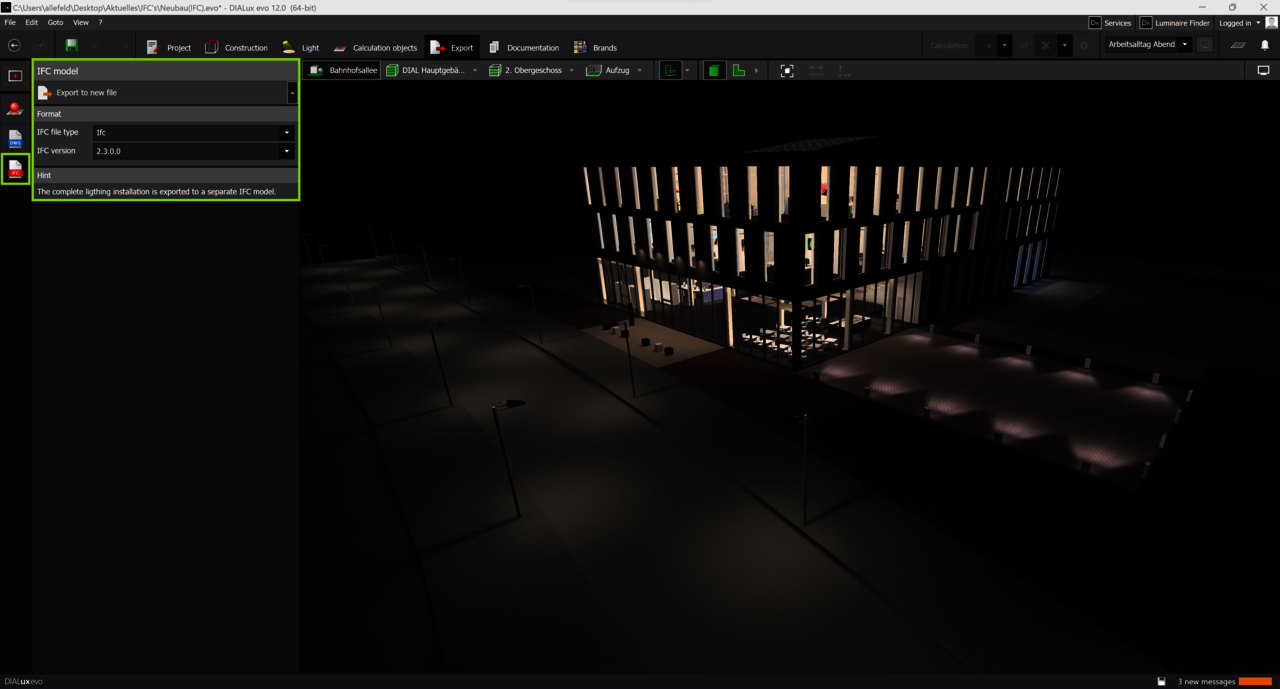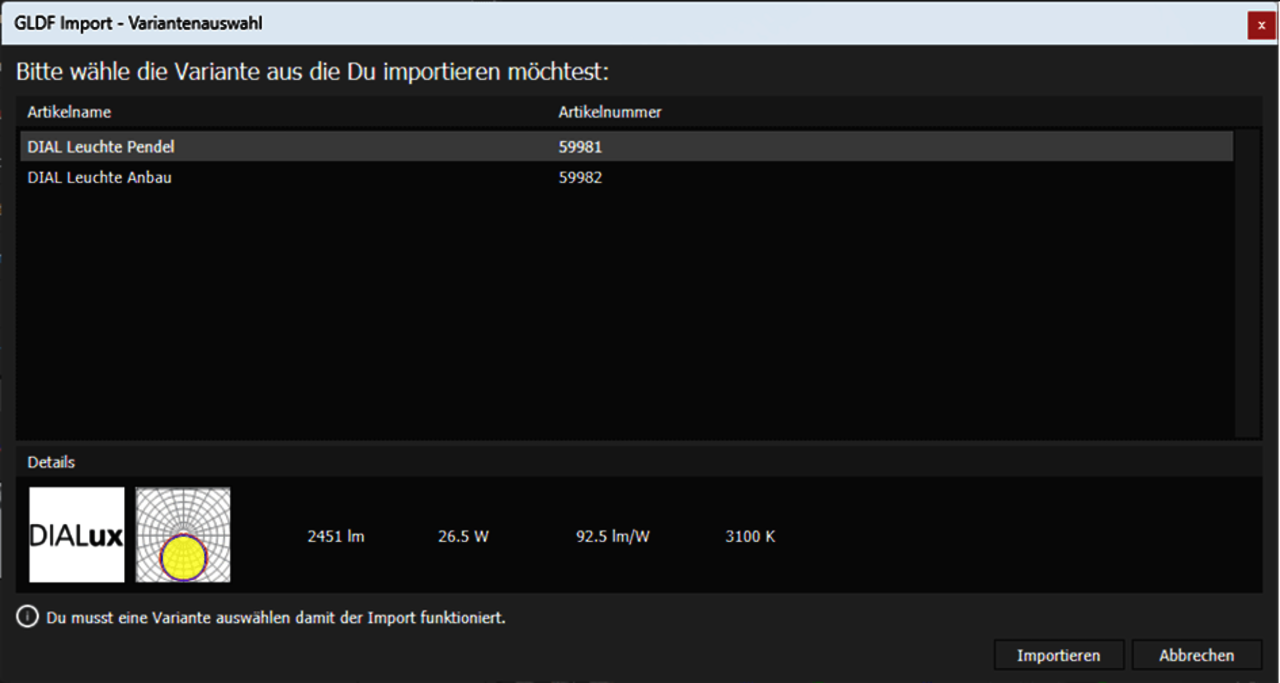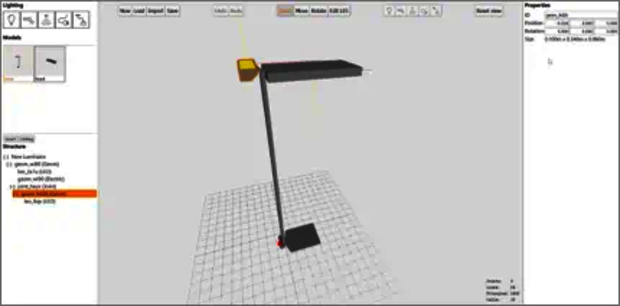DIALux evo 12
Innovations and improvements
We are happy to present the new version of DIALux evo. Our team has worked hard to make major improvements that will enhance your lighting design experience, making it more efficient and saving you valuable time.
DIALux evo 12.1 Patch 3
Version: 5.12.1.7323 | Released: 22/04/2024
Changes and fixed bugs:
- Some older projects could not be loaded.
- DIALux evo crashed on some systems at startup.
- The DWG is no longer displayed in the road planning.
- Home and End buttons work again in the text boxes.
DIALux evo 12.1 Patch 2
Version: 5.12.1.7315 | Released: 11/04/2024
Changes and fixed bugs:
- The calculation is not possible on some very old systems; DIALux can no longer be installed there.
- The results overview of the road calculation was sometimes not correct when "Calculate wet roadway surface" was activated.
- Some values could not be entered in the false color scale.
- Work areas were sometimes inserted at the wrong height.
- UGR results were sometimes not displayed in the documentation.
- Drag&drop of materials no longer worked as desired.
- The maintenance factor was not updated when changing the cleaning interval.
- Crashes (some older projects, when saving after importing furniture).
- Translation errors
DIALux evo 12.1 Patch 1
Version: 5.12.1.7275 | Released: 15/03/2024
Fixed bug:
- An error that occurred with the photometric units when they were set to imperial meant that DIALux could no longer be started.
DIALux evo 12.1
Version: 5.12.1.7272 | Released: 14/03/2024
Newly added feature
Unlock Non-Members
Starting March 1st 2024 only luminaires from DIALux Members can be used for planning and calculation in the free version of DIALux evo. If you want to use luminaires from other manufacturers without restrictions, you can purchase the "Unlock-Non Members" subscription directly from DIALux evo.
Newly added feature
Number of selected objects
You can now easily display the number of selected objects in the status bar. This works with luminaires, apertures and furnitures. All you have to do is to select the luminaires, furniture/objects or room elements. Mixed selections via the project tree are also possible.
Newly added feature
Finding luminaires that are not linked to a light scene
DIALux normally ensures that all luminaires are assigned to at least one light scene. Although, it is possible that some luminaires may become unassigned while working with light scenes. These unassigned luminaires are not included in the calculation as DIALux calculates the light scene scene by scene. The new display lists these unassigned luminaires, which can be selected and displayed in the CAD. You can now easily add these luminaires to an existing light scene or create a new one.
Improvements to known functions
Multiple selection for spaces
Rooms and spaces can now be selected and edited together in the space tool. This means that you can assign usage profiles to multiple spaces together, or assign important information with a single click. You can also change individual values within a profile, such as target illuminance, for multiple spaces at the same time. This saves a huge amount of time compared to editing each space individually.
Improvements to known functions
Create, save and load your own false colour scales
Previously, DIALux only had a global false color table. However, with the new version, you can now edit this table and add, delete, and assign colors. This feature allows you to create personalized lists for different applications, such as interior lighting, exterior lighting, and emergency lighting. These lists can be saved and reused in future projects.
Improvements to known functions
Copy and Paste of objects
You can copy and paste objects in the side views. Windows and doors stay in the wall when sliding and do not slide out.
Improvements to known functions
Handling of DWG files
The handling of DWG files has become much easier. You can now:
- Drag and drop of DWG/DXF plans on the start screen.
- Quickly select or deselect all layers for DWG/DXF plans.
- Link DWG/DXF plans with side views and align accordingly.
From DIALux 12.1, DWG plans can also be used for side or front views. Create a new plan or reuse a multi-view plan. In the appropriate CAD view, adapt it to the selected view with a single click. The plan can then be moved to the origin in the usual way, and heights, luminaire positions, roof pitches etc. can be checked and corrected if necessary.
Improvements to known functions
Programme settings
Furthermore there are some additional changes that help you to work with DIALux evo. The program settings are extended to include standard reflectance values for suspended ceilings and several room elements.
Improvements to known functions
Addendum EN 12464-1:2021
The size of the wall zone is based on the 15 % rule. The behaviour of wall zones can be configured in the settings.
Improvements to known functions
New functions and improvements for DIALux Pro
We continue to develop DIALux Pro for you and gradually enrich it with new useful functions. Therefore the Pro Feature "Unlock Non-Members" has been added to the DIALux Pro range of functions. DIALux Pro subscribers do not have to purchase "Unlock Non-Members" separately.
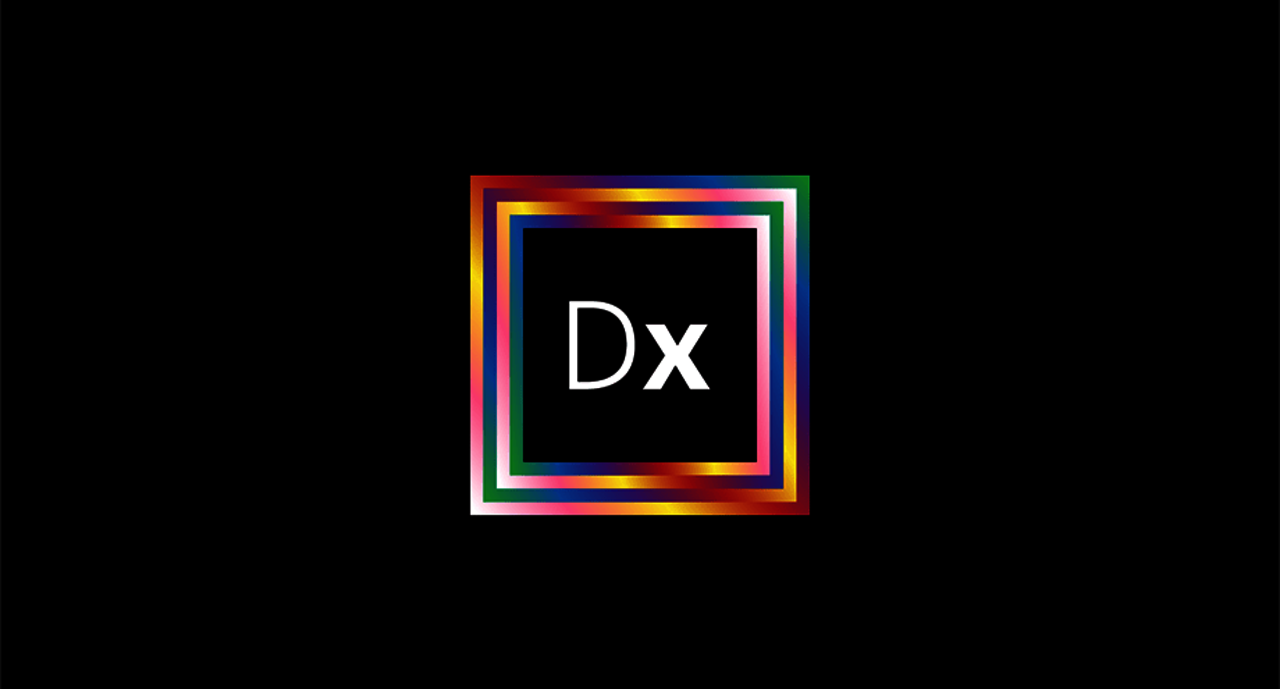
Improvements for Open BIM
We have made it even easier for you to work with BIM. You can now simply drag and drop your IFC files into the start screen.
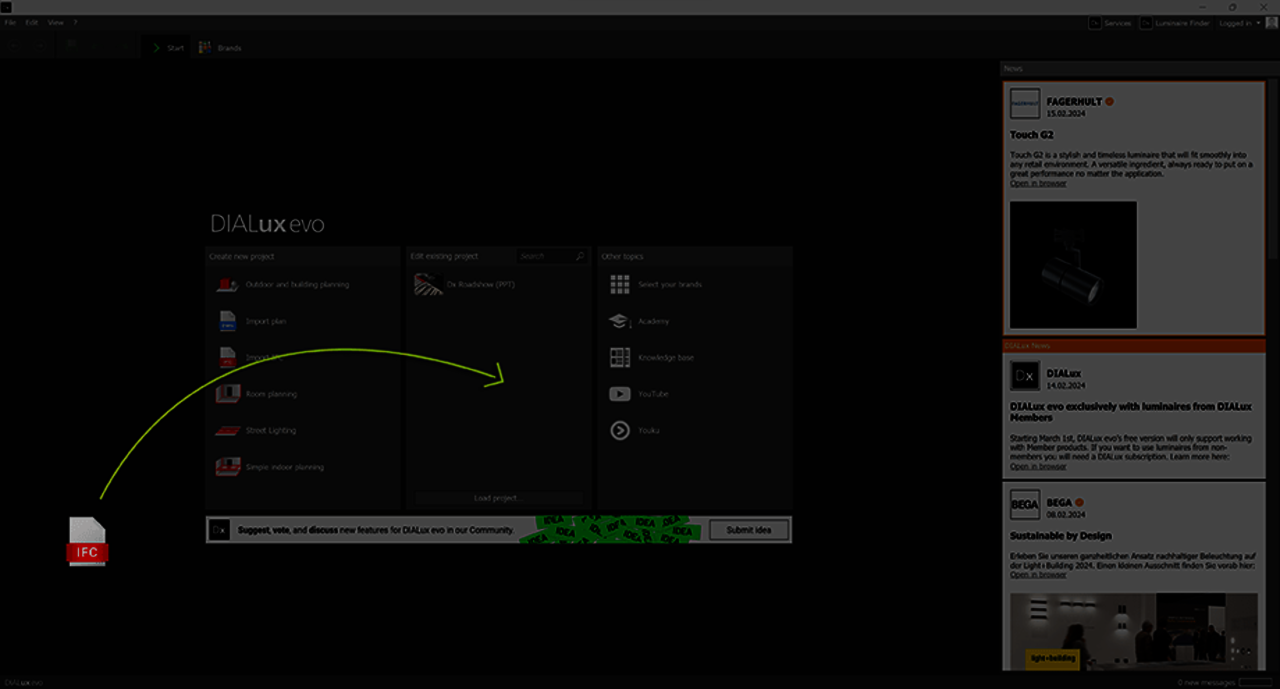
Furthermore we have worked on many IFC Import refinements
The import of material information from IFC models has been improved. Materials are evaluated more accurately and colours and transparencies are better recognised.
Automatic exclusion of standard floor element
The standard floor element is no longer automatically generated during IFC import. This change prevents potential issues where elements such as light wells in the model could be inadvertently covered by the floor element.


Roof surface integrity
An issue with IFC models causing working planes or spaces to protrude from the roof structure has been addressed. This refinement eliminates the occurrence of black roof surfaces after a daylight calculation, ensuring a visually accurate representation.
DIALux now reads all GlobalIDsfrom the imported model during IFC import and seamlessly transfers them to its own system. This allows unique GlobalIDs to be assigned to new luminaires, maintaining consistency across multiple IFC exports.
Bugfixes
Further enhancements and optimizations
- Due to missing Windows components on some systems, DIALux crashed at startup. An important process for DIALux could not be loaded as a result. DIALux no longer uses the potentially missing component.
- In some cases, projects could no longer be loaded due to missing information in the project file. This is now prevented by a repair function when loading.
- Improved performance when switching between views in large projects. A view-related energy calculation runs in the background when switching between views. The runtime behaviour of this calculation has been improved.
- Fixed long waiting time when opening the luminaire list for the first time. This is now much faster again.
- When copying along a line, too few copies were sometimes inserted. We had discovered a rounding error and fixed it.
- Fixed an issue with Snap when drawing polygonal guides in the side views.
- The pollution category in the room profile is adopted correctly.
- Unexpected patches of light in the 3D visualisation reduced. One room was illuminated, the neighbouring room was not. In the unlit room, some of the light (where the floor and wall come together) came through.
- Textures no longer moved after copying, loading or saving.
- It sometimes happened that textures were black on surfaces. This error occurred because the textures were too large. To solve the problem, DIALux now downscales such textures.
- Problems with missing GR results in the documentation solved.
- In the light scene summary, energy results are correctly documented for all light scenes. Not only in the summary for the standard light scene.
- Maintenance factors for STF import: During STF import, the absolute maintenance factor is always adopted if defined. If no absolute maintenance factor is defined, DIALux uses the maintenance method selected in the standards as a fallback.
- Several translations corrected.
DIALux evo 12 Patch 3
Version: 5.12.0.5683 | Released: 16/01/2024
Fixed were among others:
- The selection of the reflection column in the RUG calculation
- Textures of furniture and objects after saving and loading
- Calculation after inserting outdoor areas
DIALux evo 12 Patch 2
Version: 5.12.0.5620 | Released: 23/11/2023
Fixed were among others:
- RUG calculation
- Problems in the documentation
- Number of grid points in the street could not be changed
- Security updates (Chromium and .NET)
- SilentSetup did not work if .NET 6 was not already installed
DIALux evo 12 Patch 1
Version: 5.12.0.5586 | Released: 26/10/2023
- Even if the luminaire catalogues are open in the background, projects can be saved again
- If Thai is set as the language, older projects can be loaded again
- For our test infrastructure, we implemented something in the luminaire list that made it extremely slow to open. The luminaire list should open quickly again
- We have solved connection problems from DIALux to our online services. This affected users who had configured a proxy server
- We use software libraries from other suppliers for DIALux. Due to an update of such a library, luminaires were incorrectly oriented during the DWG export. This should be fixed with this patch
- We have fixed issues when combining objects
- The numbering of the luminaires in the luminaire layout plan are now sorted in ascending order per arrangement
- Various translation corrections
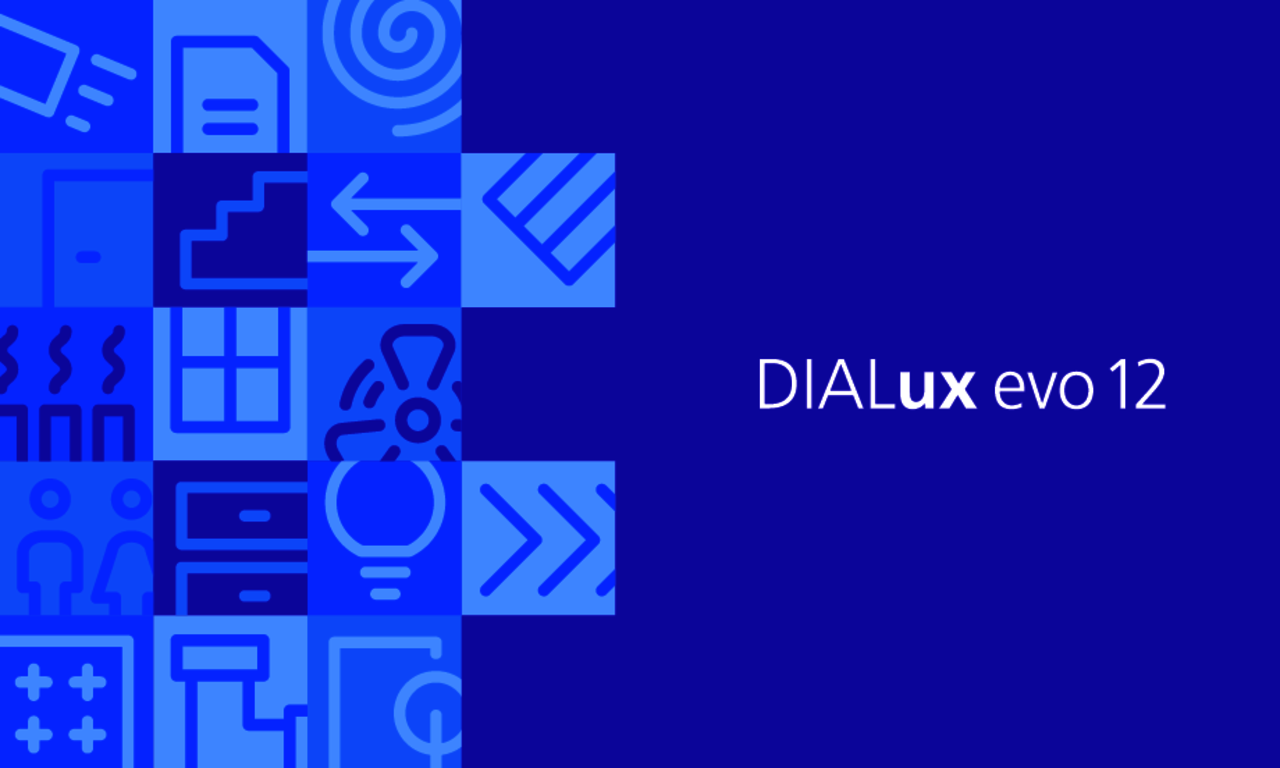
DIALux evo 12
Version: 5.12.0.5527 | Released: 20/09/2023
IFC Import
DIALux now supports the complete IFC structure in the form of a tree diagram. You can now decide which IFC objects to import into DIALux. This version supports the formats IFC 4.0 and IFC 4.1, including the geometry descriptions of version 2x3. In the future we also plan to support newer IFC geometry formats.
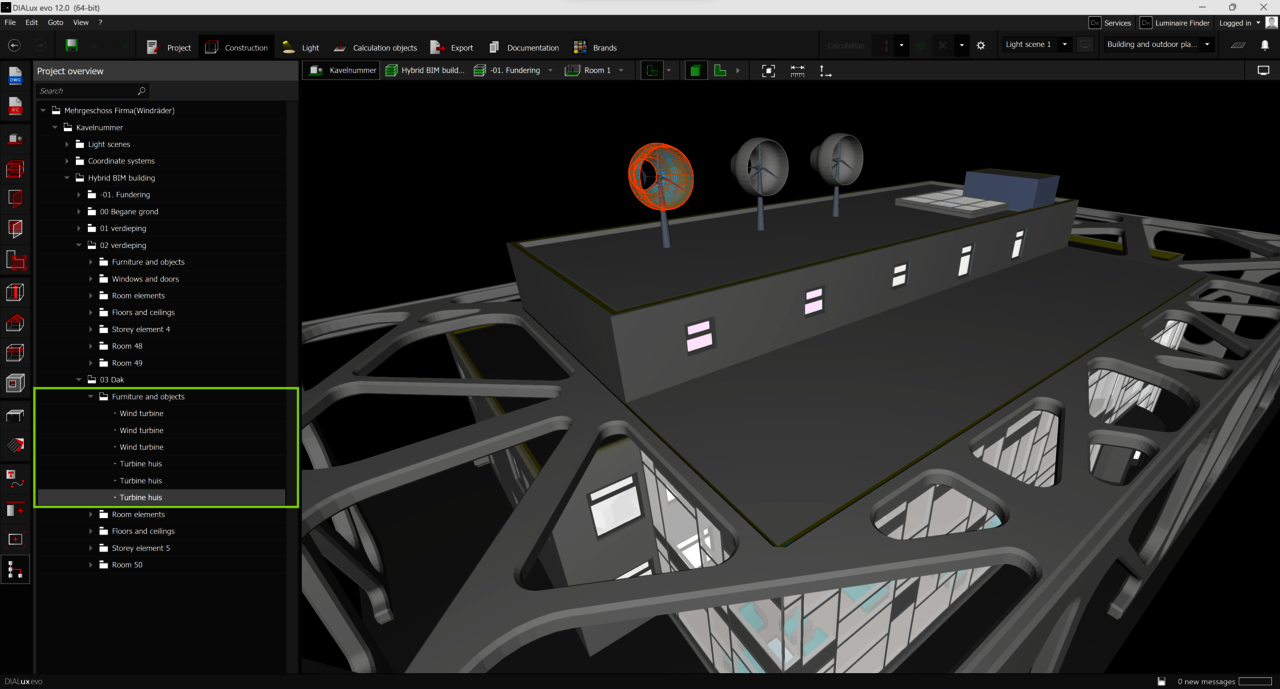
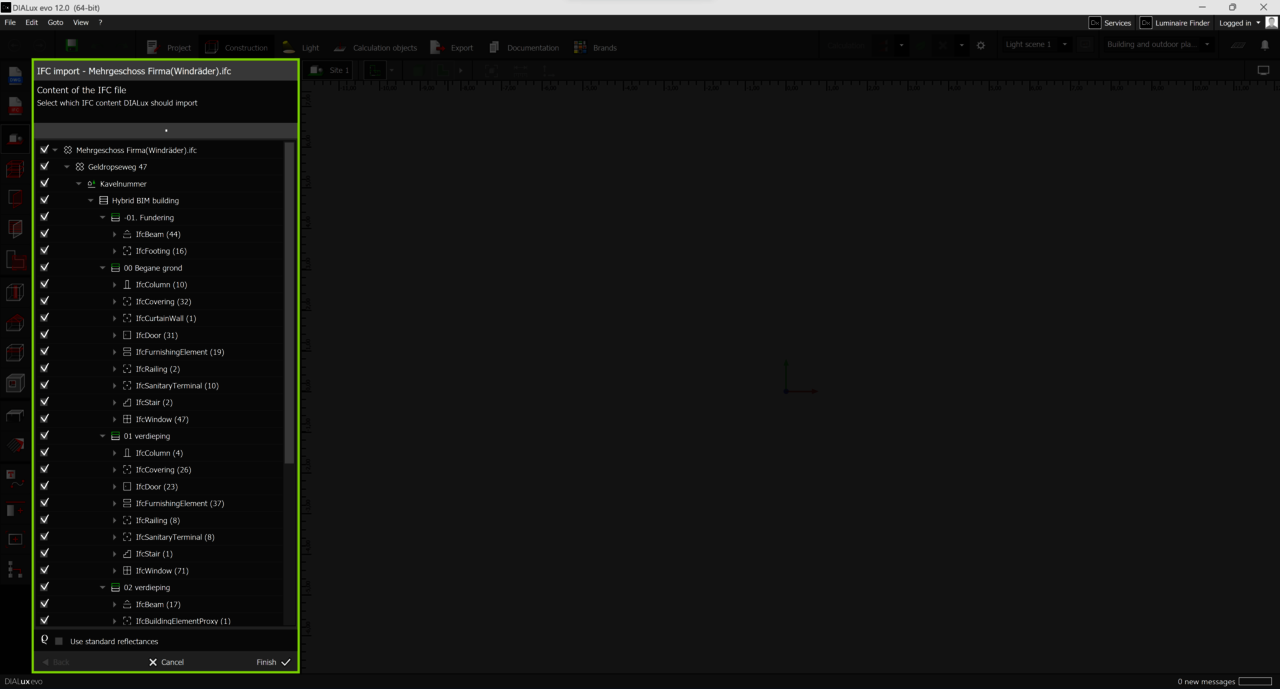
We have introduced a new tool called "IFC Model" under the "Construction" menu to work with the new IFC objects. When you select them, you get detailed information including global ID, IFC type, name and description. These IFC objects can be removed from the scene using the tool.
For example, to save calculation time, you can decide to exclude the new IFC objects from the calculation or to simply illuminate them. DIALux treats the new IFC objects similarly to furniture, especially if no furniture and no IFC objects are present.
The new IFC objects are also the content of plans in the documentation. The objects can be selected and deselected from the page settings.
At the end of the design, you can export the lighting model as a separate IFC file. In this release we limit the file format to IFC 2x3 and you can specify whether the IFC file should be compressed at the same time or saved as IFC XML for web applications. Such a partial model can be returned to the BIM process to extend a common building model. The alternative: The partial model can be used as input for other Open BIM-enabled CAD programs.
Scope of the IFC export
DIALux takes the building structure such as terrain, buildings and floors from the IFC building model. All luminaires are drawn into this building structure with their correct 3D geometry and coordinates (WYSIWYG). The export takes the length unit from the building model. Articulated luminaires are exported as a fixed model in their fully aligned state.
In addition, each drawn IFC luminaire has the following properties:
- Item name
- Item number
- Item description
- Manufacturer
- Mounting type
- Reference surface (floor, wall, ceiling)
- Emergency lighting operation possible (yes/no) Product feature
- Total system connected load (sum of all Leos)
GLDF
With DIALux evo 12.0 you can import luminaire data in GLDF format. GLDF (Global Lighting Data Format) is a new, modular lighting data format with a clear XML structure that describes simple to complex luminaires and sensors. It is an open and freely available data format. More information is available at gldf.io.
Luminaires from DIALux members can be imported in the usual way using drag and drop or the import function. In addition, GLDF data can contain different product variants that differ in terms of electrical, photometric or appearance. The variant is selected during import. GLDF data from non-members can also be imported, but will be subject to the previous restrictions.
GLDF also supports the new L3D geometry model. The new L3D editor makes it easy to create luminaire models from OBJ data.
Changes to familiar functions
- As part of the Open BIM development, the contour recognition of rooms from IFC building models has been improved. This allows DIALux to now process IFC models that were previously unable to be loaded
- The Solid Modeler Library (SMLib) has been updated, various errors have been fixed, and improvements have been made to the Solid Modeler
- The IFC import feature has become more tolerant. If IFC objects cannot be loaded, DIALux will attempt to skip them instead of aborting the import process
- The processing of standard daylight control systems has been slightly accelerated, as well as the calculation of potential energy assessments
Bugfixes
- Issues with loading projects
- Errors when generating outputs and when creating calculation surfaces
- Errors in charting on the calculated road
- Adjustments to tooltips for forward/backward navigation
- Correction of translation errors
- Error in the number of placed windows
- Performance improvement when loading daylight systems
- Resolution of an issue where deleting the last luminaire group also deleted the lighting scene
- Renaming option for the emergency lighting scene and improvement in documentation presentation to display location information above the heading on image pages as well
